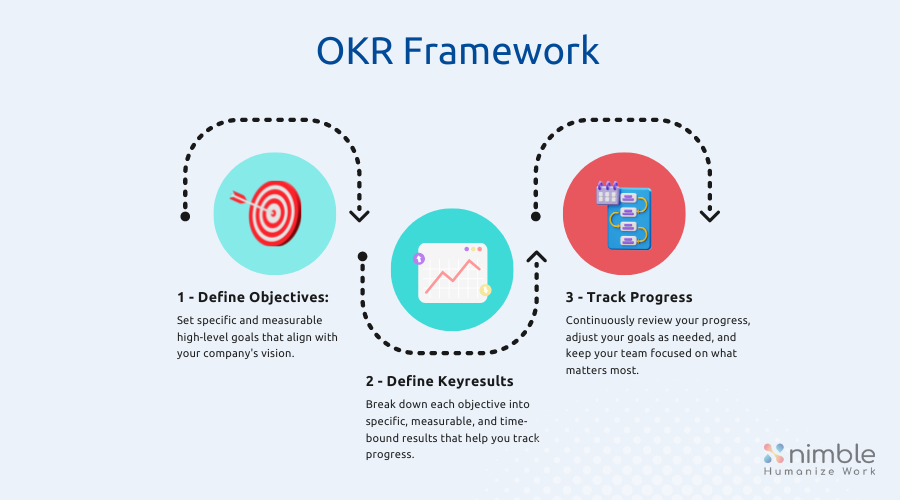Goal-setting is one of the most vital topics for organizations. After all, how can you achieve your objectives if you don’t know what they are? How do you expect to motivate your workforce and create alignment if you don’t have shared goals to pursue as a team? When it comes to goal-setting in organizations, an approach that stood the test of time is the OKR framework. You might have heard about it; we have written about it, more than once.
Despite its many strengths, the OKR framework isn’t a silver bullet—no approach is. It is quite possible to do a bad job when implementing OKRs.
In this post, we’ll walk you through the main mistakes in OKR implementation, so you can learn to avoid them. Before that, though, let’s review the motivations behind adopting OKRs.
The Benefits of OKRs
Why bother with OKRs? What can you derive from them?
Alignment and focus are the main drivers behind adopting OKRs. By establishing objectives that resonate across all organizational levels, you ensure that everyone is striving toward a common goal. This prevents inefficiency—no one should be engaged in initiatives that contradict the organization’s objectives—while also cultivating a sense of alignment and purpose.
OKRs also enable the cultivation of accountability and motivation throughout the organization. A crucial aspect of employing the OKR framework is the ongoing tracking of objectives to ensure their achievement, prompting individuals to feel responsible and motivated in their work.
5 Biggest Mistakes in OKR Implementation
There are many ways things can go wrong with your OKR implementation, and talking about them all would make for an impossibly long article. However, not all mistakes are committed with the same frequency; thus, it makes sense for us to focus on the mistakes that are both common and more likely to wreak havoc.
1. Having “Unactionable” Objectives
At the surface level, OKRs don’t sound hard:
👉 Have one or more objectives that align with your organization’s strategy
👉 For each objective, have a few key results you want to achieve
However, getting objectives wrong is quite common. You see, objectives have to be actionable. You must be able to envision a future when that objective is accomplished and describe it to someone.
The mistake here is that people will often write things that sound more like themes or areas of focus, and call them objectives.
To make things clearer, let’s use an analogy related to New Year’s resolutions. “Health and fitness” isn’t a resolution. “Drop <x> pounds by <y> month is.” Or maybe “run a half-marathon under <x> yours by <y> date.”
Let’s come back to the OKR context. “Efficient cloud spending” isn’t an objective. But “Optimize Cloud Infrastructure Efficiency to Reduce Costs by 20% in the Next Quarter”, on the other hand, is way better. It is actionable, quantifiable, and timely.
2. Lack of Adaptability
Repeat after me: “It is OK to change your mind when presented with new evidence.” Why am I stressing that?
Adaptability is a core principle in the OKR framework. It’s important to shift gears when the current plan doesn’t quite fit anymore.
The business landscape changes fast. At times, your set OKRs might become outdated due to these shifts. That’s life. Doggedly sticking to them would be a misstep.
“Oh, but we already invested so much into this!”, I hear you lamenting. It doesn’t matter. This is the sunk cost fallacy, and economists have been warning us against it for decades now.
If the landscape changed, but your outdate OKRs still linger, you’re in for trouble. Change them ASAP.
3. Lack of Alignment
One of the main purposes of adopting OKRs is creating alignment inside the organization. Thus, it makes sense that one of the biggest mistakes you can mike is when OKRs lack alignment. What do I mean by that?
Your OKR implementation can lack alignment in several ways. First of all, they can be misaligned with the overall strategies of the company.
Let’s say that an important strategic goal for your company for a given fiscal year is to improve on its DEI (diversity, equity and inclusion) front. In such scenario, would an OKR with the objective “Cut hiring spending in 70% for the next fiscal year” make sense? Probably not, since to improve diversity and inclusion, you’d probably have to invest rather than cut costs on hiring.
Additionally, key-results belonging to an objective have to align both with the object and among themselves. You have to think of KRs as steps you take to accomplish the overall objective; otherwise, they become just arbitrary tasks.
4. Misunderstanding Your Capacity
This mistake is actually two joined into one: underestimating and overestimating your team’s capacity. What does that mean?
One of the OKR framework’s tenants is the idea of stretch goals. When defining OKRs, you should write down goals that are just outside the limits of your current capacity, in order to motivate—”stretch”—your team, making them achieve more than they thought was possible.
However, there’s a risk of going too far, establishing objectives that far exceed the organization’s current capacity, potentially jeopardizing the psychological safety of your coworkers.
The opposite can also happen: to underestimate what your team can do, and thus set goals that are too safe. That way, you’re not only not achieving the maximum goal for the organization, but also curtailing the potential growth of your team.
5. Having Misconceptions About OKR Components
The last mistake we want to cover is related to the first one—and, in some way, emcompasses it—but it goes further.
It has to do with misunderstanding each of the OKR components. Often, teams write key-results as if they were tasks: too much minutiae and unnecessary details. They can also write objectives as if they’re key results, keeping them too focused on specifics that are to be achieved.
So, here’s a refresher. Objectives need to be bold and inspiring. Sure, they need to be specific instead of vague, actionable instead of being the name of a theme, and time-bound instead of not having any time horizon. But they don’t need to go down to the level of how you’re accomplish it. The “how” belongs to the key-results.
For the key-results: they don’t need to get to the level of day-to-day activities. Key-results aren’t a task list. Instead, they represent the most important results the organization needs to achieve in order to support the overal objectives, but the daily and weekly tasks are generated according to the descrition of individuals and teams working on the various projects related to such KRs.
Conclusion
“All happy families are alike; each unhappy family is unhappy in its own way.” This is the opening quote from Anna Karenina, a romance from Tolstoy considered of the greatest books of all time.
All successful OKR implementations share common traits, while unsuccessful ones each have their unique pitfalls. Avoiding the mistakes outlined in this article—ensuring aligned OKRs, a comprehensive understanding of the framework, accurate team capacity estimation, and more—increases the likelihood of a positive outcome in your OKR journey. Ready to transform your approach to OKRs? Explore Nimble OKRs for a seamless and effective implementation. Achieve your goals with Nimble OKRs.









